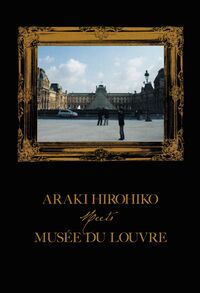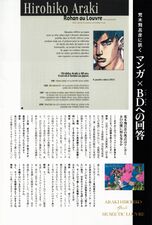Rohan au Louvre (May 2011)
Hirosegawa (February 2011)
Interview Archive

An interview with Hirohiko Araki included in the Japanese hardcover edition of Rohan au Louvre, titled ARAKI HIROHIKO Meets MUSÉE DU LOUVRE, that was released on May 31, 2011.
Interview
Firstly, please tell us how you came about getting involved in this project?
Araki: It all started because of a conversation I had with Akiya Takahashi (the founding director of the Mitsubishi Ichigokan Museum) while I was helping him with his "Musée d'Orsay" exihibition ("Musée d'Orsay: A 19th Century Artists' Paradise" which was held in 2007). He told me that he had heard about the offer through a newspaper company, which is how I got involved.
What were your thoughts when you first heard about the offer from the Louvre?
Araki: I felt honored, but at the same time it felt too good to be true. (laughs) I was like, "Really, the Louvre?" (laughs) Japanese manga is not something that comes to mind when you think of the Louvre. But when I found out the offer was true, I felt honored. I'm also grateful to all the people at the papers who acted as my intermediary, even though they really had no incentive to.
This is your first work in full-color. Was that something you planned from the beginning?
Araki: I heard that the other authors involved in the project were doing full-color, so I figured I might as well do it too.
When Fabrice, the project manager, visited to Japan to see your black and white manuscripts for Steel ball Run, he said: "It has a certain appeal that's impossible to ignore. If you want to push the Japanese style of making comics, I think it would be great if you drew it in black and white."
Araki: Thank you. That was definitely an option, but since opportunities like this don't come by very often, I decided it would be a nice change of pace to do it in full-color.
The illustration on the cover is very impactful, don't you think?
Araki: The cover uses the three colors that symbolize France: white, red, and blue. Most old Japanese paintings feature a motif of clouds and waves, so I included a wavy pattern to give it a Japanese touch.
The colors in the story are a lot more subdued compared to the cover, aren't they?
Araki: I figured that if I used my usual coloring method for the entire story, the readers would get tired of it, and that would be bad. So I decided to keep a balance that would encourage the readers to keep reading. I was given several French comic books to use as reference, such as works from Nicolas de Crécy and etc., which I studied to get a sense for drawing in full-color.
The story first takes place in Japan, then the Louvre, and lastly underground.
Araki: That's right. The first part is the most Japanese as it takes place in Japan, and since it's in the past, it has a sepia tone. I was very conscious of what tones I should use for stuff like Tatami mats. Once we arrive in Paris, it's pink, and down in the underground, it's blue. I did the first undercoat of paint the same for all parts of the story, and then later decided to split them into different colors.
In the book, we get to see a lot of Japanese things, such as traditional Japanese houses and yukatas (summer kimonos).
Araki: I intentionally did this with French readers in mind. I don't usually get to draw these type of things, so it was very refreshing and enjoyable.
The main character is Rohan Kishibe, a manga artist from Part 4. Did you plan to have Rohan as the protagonist from the start?
Araki: Well, I was actually asked to create a new character, and not one from JoJo. But I knew from the very beginning that the story would feature a manga artist like Rohan going to the Louvre. So I thought, why don't I just use him? (laughs)
The combination of the Louvre and Rohan must've been a perfect match For Japanese readers.
Araki: Besides, had I created a new character from scratch, it would've taken a dozen pages in order to properly introduce them, and that would've made it a lot more difficult for readers to jump into the story. Also, if an author writes a character they're familiar with, they can more easily present them to readers who have no idea who they are, like Rohan. I consulted this with the guys at the Louvre and managed to get them to approve it.
So you had some idea of what the plot was going to be from beginning?
Araki: That's right. It was something along the lines of Rohan pursuing a mystery in the Louvre... But the Louvre is a pretty big place, so I had to narrow down the places I wanted to show. I thought it would be cool to have a shady looking underground area, and during the investigation, Rohan would be shown going down into it from the upper floors.
At the time, I was very curious where all the paintings not put on display were stored. There are many masterpieces that are either not in perfect condition or are undergoing restoration that can't be shown to the public. This made me wonder if something like the "black painting" in the story could be kept there.
The Rohan we see pursuing the painting is a bit different from his eccentric self in Part 4. It was also very interesting seeing Rohan before his debut as a manga artist.
Araki: This time, I drew him as a character specifically for the Louvre, so it's a bit different from how I drew him for JoJo. But who knows, maybe he was doing eccentric things off-screen too (laughs).
Rohan's first love was also never shown before, but we get to see her in the story.
Araki: I mostly associate French films with "erotic thrillers", which feature a sort of secret love or affair. Japanese films have this too, but I wonder if it was originally influenced by France. So I put a bunch of old romance tropes throughout the story. (laughs)
The story features a lot of poses, such as in the spread where Rohan arrives at the Louvre.
Araki: That pose was taken from Michelangelo's "Dying Slave" sculpture. Since the Louvre is the main focus of the book, I tried paying homage to many of the works in its collection. The scene where Rohan tries to read Nanase's memories is also inspired by Antonio Canova's sculpture "Psyche Revived by Cupid's Kiss." I added more references here and there, so I would be pleased if you tried looking for them all.
How did you feel exhibiting your works in front of French comics for the first time?
Araki: As one of the few Japanese artists presenting their works, I felt that I had to give it a distinct Japanese look. That's why I came up with the story of it taking place in Japan and going to the Louvre, connecting the two places.
What were some of the differences you found between French comics and manga?
Araki: The most obvious one is how the cover illustrations are presented. I was surprised when the Louvre asked me to draw mainly landscape artworks. When I looked at other works, I saw that they were mostly draw wide with the characters small. This is the exact opposite of the methodologies used in Japanese manga.
What do you think are some of the characteristics of French comics?
Araki: I think it's the pursuit of drawing something in a way that's never been done before. In the case of Japanese manga, the goal is to draw something that's accepted by the readers, but French comics ignore this and go in the total opposite direction. It's very liberating, and forces you to go out and draw your own way. That's what differentiates it from Japanese manga.
Did your impression of the Louvre change after the exhibit?
Not at all. I keep wondering if there are hidden passages behind the walls, despite having been behind the scenes. After all, the Louvre is still the Louvre.
How do you feel about having your paintings exhibited in the Louvre?
Araki: I'm in awe. (laughs) The Louvre is a place that even Gauguin and Picasso couldn't get into, because it only exhibits pre-modern works. It's truly an honor to have my art exhibited in the same place as the Mona Lisa and the Venus de Milo.
[Translated by Morganstedmanms (JoJo's Bizarre Encyclopedia)]
荒木飛呂彦の視点はマンガとBDの間に何を見るか
――まずはこのプロジェクトに参加することになった経緯を教えてください。
荒木 以前 『オルセー美術館展』(07年開催の『オルセー美術館展/19世紀芸術家たちの楽園』)のお手伝いで、高橋明也先生(三菱一号館美術館初代館長)と対談させていただいたんです。そのきっかけを作ってくださった新聞社さんを通じて、依頼をいただいたと聞いてますね。
――最初、 ルーヴル美術館からの依頼と聞いた時、どう思われましたか?
荒木 光栄なこと、と思うと同時に「本当なのかな?」って(笑)。どこのルーヴルですか、みたいなね(笑)。だって、ルーヴルとマンガって、イメージ的にすぐには結びつかないですよ。 でも本当にあのルーヴル美術館からの依頼だとわかって、とにかく光栄だと思いましたね。あと、自分たちの利益とかに関係ないのに、仲介してくれた新聞社の方々には感謝してます。
――今回、初のフルカラー作品ですが、最初からその予定だったんですか?
荒木 このプロジェクトで刊行されてる他の作品がフルカラーだって聞いたので、「じゃあ僕もフルカラーでやります」って感じですね。
――プロジェクト責任者のファブリスさんが来日された時に『スティール・ボール・ラン』のモノクロ原稿を見て「捨てがたい魅力。日本のスタイルを押し出すなら、モノクロで描くのも素晴らしいのではないか」とおっしゃってましたが。
荒木 ありがたいですね。 確かにそういう選択肢もあったんですけど、こういう機会もなかなかないので、 フルカラーでやってみるのもいいかな、って。
――カバーイラストからインパクトありましたね。
荒木 カバーイラストはフランスに敬意を表して、トリコロールにしてます。 白・赤・青の三色ですね。そこに日本のテイストを意識した模様を入れました。雲や波の感じをイメージした、昔の日本画にあるようなモチーフですかね。
――本編ではいつものカラーリングではなく、ちょっと色調を抑えていますよね。
荒木 いつも使ってるカラーリングで全編構成したら読む側が疲れるな、ヤバイな、と。だからストーリーを読んでもらうためのバランスでいこうと考えました。参考のために何冊かBDの作品をいただいて、ニコラ・ド・クレシーさんの作品とかを見て、フルカラー用の色彩感覚を学びましたね。
――日本が舞台の前篇、 ルーヴルに舞台を移す中篇、地下で展開される後篇と、色合いが変化していきますね。
荒木 そうですね。 最初の日本篇は和風だし、過去のエピソードなのでセピア調。畳とかの色合いを意識してます。パリに到着するとピンク、 地下ではブルーを基調にしてます。 全篇、下塗りを最初にしてるんですよ。パートごとに基調になる色合いを意識的に分けてます。
――日本家屋や浴衣といった日本的なモチーフが随所に登場しています。
荒木 フランスの読者を想定して、そこも意識的に入れましたね。自分でもそういうモチーフはあまり描いてなかった所なので、新鮮で楽しめましたよ。
――主人公は第四部のキャラクター、マンガ家の岸辺露伴です。 最初から主人公は露伴で考えていたんですか?
荒木 本当は『ジョジョ』のキャラクターではなくて、 オリジナルのキャラクターにしてくださいと言われたんですけどね。ただ、露伴みたいなマンガ家のキャラクターがルーヴルに行く話になるな、ってのは当初からあって。だったらもう、露伴でいいんじゃないか、と(笑)。
――日本の読者的にはルーヴルと露伴の組合せという時点でグッときます。
荒木 それに、新たにキャラクターを起こすと、その紹介だけで平気で何十ページかかりますから。そうすると、なかなルーヴルの物語に入っていけない。 作者がキャラクターを把握していれば、露伴を知らない読者にもスムーズに提示できるんですよ。そう言ってルーヴル側に相談して、何とか了承してもらえました。
――そうすると、ストーリーも当初からある程度構想して行ったんですか?
荒木 そうですね。露伴がルーヴルで何かの謎を追う…‥くらいの。でもルーヴルは広大なので、描くポイントを絞る必要があるなと。それで、何か不穏なものがあってもおかしくない地下がいいなと考えて、取材では地下と屋根裏を中心に見せてもらいました。 表に出ていない所蔵作品がどんな風に、どこに保管されてるのかが気になってたんですよ。絵っていうのは、完璧でない状態だったり、修復中でとても見せられないものでも、名作だったりするものはある訳だから、作中の「黒い絵」みたいのが、どっかにあるんじゃないかな、と。
――その絵を追う露伴は、第四部でのエキセントリックな印象とはちょっと違いましたね。デビュー前の露伴の描写も興味深かったです。
荒木 今回はルーヴル用のキャラで描いてるので、 『ジョジョ』用に描いてるのとちょっと違うんですよ。でも、描かれてないとこで変な事もしてたのかも(笑)。
――露伴の初恋?も描かれてました。
荒木 フランス映画っていうと「エロティック・サスペンス」っていうか、秘められた恋と事件みたいなイメージがあるんですよ。日本もちょっとそういうとこがあるけど、フランスと日本のそういう感じを融合したっていうか。 クラシック恋愛要素を随所に入れて(笑)。
――露伴がルーヴルに到着した見開きなど、ポージングも随所に。
荒木 あれはミケランジェロの「瀕死の「奴隷」という彫刻のポーズです。 ルーヴルが題材なので、所蔵作品へのオマージュを入れてるんですよ。露伴が奈々瀬の記憶を読もうとするシーンも、アントニオ・カノーヴァの「アモルの接吻で蘇る「プシュケ」という彫刻のポーズ。 ちょこちょことそういうの入れてるんで、探してみてもらえたら嬉しいですね。
――今回、初めてBDのフィールドで作品を発表してみて、どうでしたか?
荒木 日本人に話を振られた以上、日本人らしさを出さないとダメだと思ったんですね。だから日本人がルーヴルへ行くという、日本とルーヴルがどう関わるか、というストーリーになったんです。
――BDとマンガの違いを感じたポイントって何がありますか?
荒木 わかりやすいとこだとカバーイラスト。 ルーヴルからは当初、風景メインで描いてくれっていう注文があって、びっくりしましたね。 他の作品見てみたら、みんなロングで描いてて、 キャラが小さいんですよ。わりとキャラに寄ってても目線が来てなかったり。日本のマンガの方法論とは真逆ですよね。
――荒木先生が考えるBDの特徴は?
荒木 誰も描いたこともない描き方みたいなのを追求してるとこですね。日本の場合は読者に受け入れられなければいけないっていう目的があるけど、それを無視して、むしろ逆走してるみたいな。その感じがスゴイですよ。 我が道を行かなきゃダメっていう突き抜け感なんですよね。そこが日本と全然違うと思う。
――今回、仕事をしてみて、ルーヴルの印象って変わりましたか?
荒木 別に変わらないです。 この壁の裏が実は通路だったのかとか、裏側を見れたというのはあるけど。やっぱりルーヴルはルーヴルなんですよ。
――そんなルーヴルに自身の絵が展示された感想はいかがですか?
荒木 畏れ多い(笑)。ルーヴルって近代より前の作品だけだから、ゴーギャンとピカソでも入れない場所なんですよ。そんな場所に展示されて「モナ・リザ」や「ミロのヴィーナス」と同じ空間に自分の絵があったっていうのは本当に光栄です。









